ASUS G73SW + SNB: Third Time’s the Charm?
by Jarred Walton on March 4, 2011 12:00 AM ESTApplication Performance: Plenty Fast
We’ll start with our standard set of application results. Here’s where the Sandy Bridge processor upgrade really helps the G73SW distance itself from the previous iteration. What would help even more would be to get an SSD in the system as the OS/app drive; even a 60GB model would be fine, but personally I find 120GB to be the sweet spot. The main comparison here is going to be with the MSI GT680R and the older G73JW, although the Clevo P170HM is also worth a look. As the unit we tested had an SSD, the P170HM is going to really pull ahead in the PCMark tests.
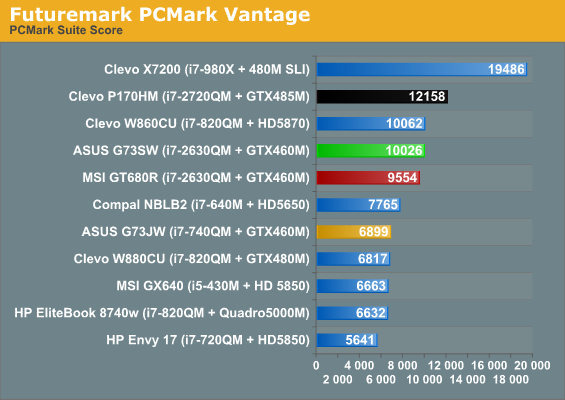
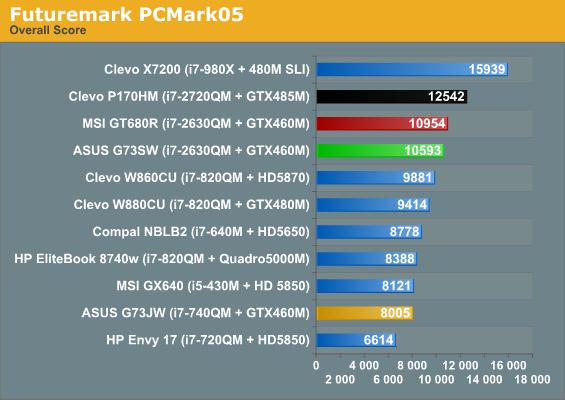
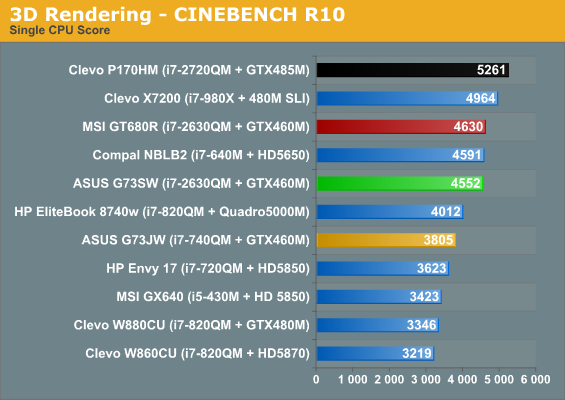
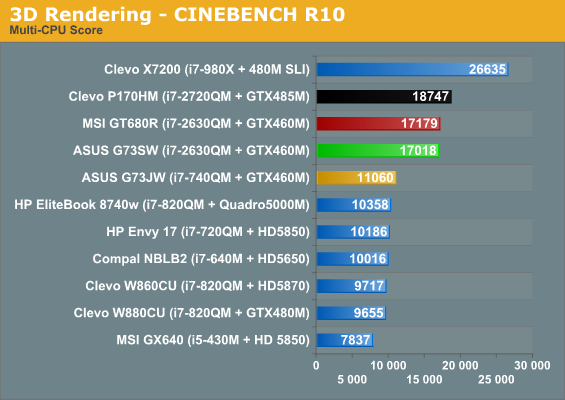
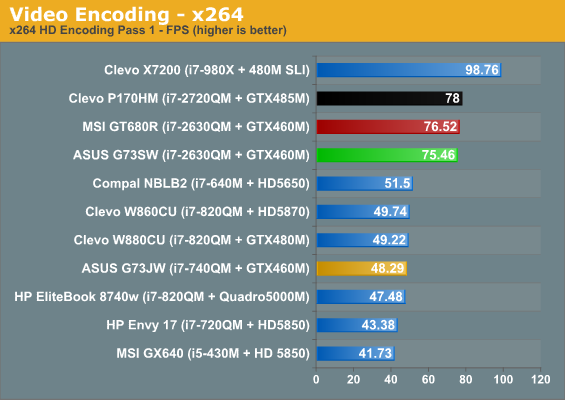
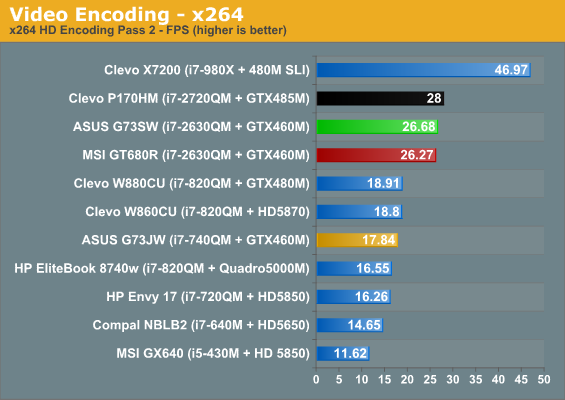
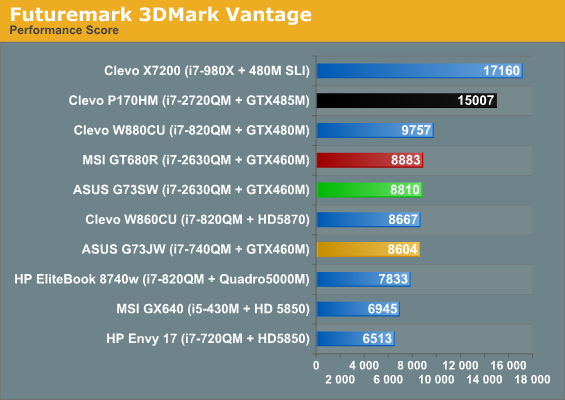

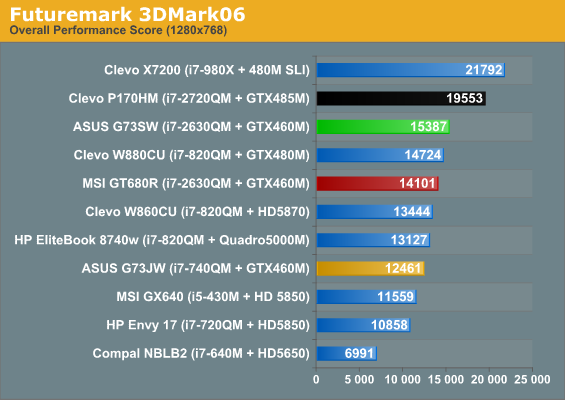
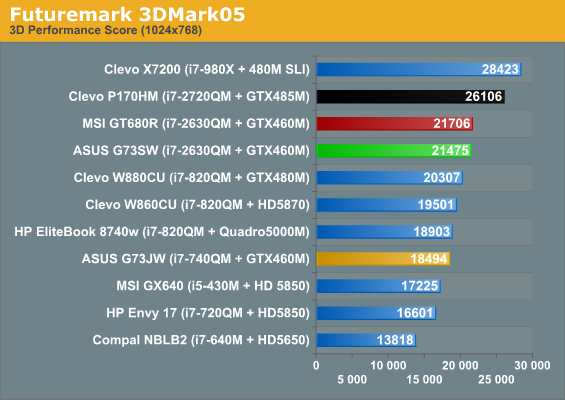
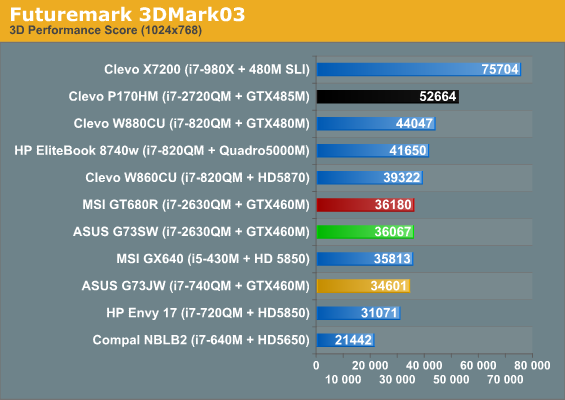
So the first point of interest is just how much faster the G73SW is compared to the G73JW. It leads by 45% in PCMark Vantage (and that’s without an SSD), 32% in the older PCMark05, and anywhere from 20% in the single-threaded Cinebench results to as much as 58% in the multi-threaded tests. In fact, all of the heavily threaded benchmarks are at least 50% faster with Sandy Bridge. Wow. But we already knew that. What about some more recent competition?
MSI’s GT680R has pretty much the same specs, only with RAID0 HDDs instead of individual drives. Oddly enough, the G73SW still came out slightly ahead in PCMark Vantage (by 5%), a test that’s particularly kind to fast storage subsystems (particularly SSDs). PCMark05 puts the GT680R ahead by a similar margin (3.5%), but Vantage is arguably more pertinent in today’s market. Elsewhere, the comparison is largely a wash, with MSI winning three, ASUS winning two, and a tie in the final test. All of the margins of victory are close enough to call it a tie. So, despite having a larger (and ostensibly cooler running) chassis, the G73SW delivers about the same performance as that of the GT680R, which is still very good.
The other point of comparison is the recent Clevo P170HM, which has a faster i7-2720QM CPU and a much faster GTX 485M GPU. The latter mostly won’t matter here (except for PCMark05), but the 2720QM does carry a small clock speed advantage, and the Crucial C300 SSD will definitely help in PCMark Vantage—good for a 21% lead, in fact. it has an 18% lead in PCMark05, with help from both the SSD and GPU. The remaining tests are purely CPU limited, and the lead ranges from 3-5% in x264 encoding to as much as 15% in the single-threaded Cinebench result where the more aggressive Turbo Boost on the 2720QM comes into play.
Recall that the 2720QM can Turbo to 3.3GHz from the stock 2.2GHz for single-threaded work, and still hit as high as 3.0GHz with all four cores active; in contrast, the 2630QM maxes out at 2.9GHz single-threaded, or 2.6GHz for all four cores. It looks as though x264 encoding isn’t able to Turbo as high as Cinebench for some reason, as even the heavily CPU bottlenecked second pass is still only 5% faster with the 2720QM, despite a potential 10% to 15% clock speed advantage—or maybe it’s that the G73SW is able to run at the maximum 2.6GHz, whereas the P170HM might have to drop down to 2.7-2.8GHz due to temperature.
Any way you slice it, the quad-core Sandy Bridge processors are very fast for general computing work. It’s just a shame that the use of the PM67 chipset and discrete GPU means there’s no way to access the CPU’s QuickSync feature. That’s one more reason switchable graphics really makes sense in notebooks, but it does add some complexity that some of the OEMs prefer to avoid. So far, no one has been willing to try NVIDIA’s Optimus Technology with any mobile GPU faster than the GT 435M, although we hear there’s a GT 555M Optimus notebook coming some time in 1H’11.










56 Comments
View All Comments
ph00ny - Tuesday, March 8, 2011 - link
What about the higher res screen? laptop bluray drive?you're really starting reach with aftermarket this and aftermarket that
Kaboose - Saturday, March 12, 2011 - link
Blu ray is pointless, i download everything including 1080p movies. the screen isnt a big deal as long as it is bigger then 1336x768 at this size it is fine.Penti - Friday, March 4, 2011 - link
It's really a mistake not to build a consumer gaming laptop on a hybrid solution. What good is it if it can not work as a portable DTR? We have seen where all the other high-end offerings have gone. People do like a laptop that can say play Starcraft 2 but also likes to actually have the ability to use it unplugged. You shouldn't have to chose any more, you can have portable gaming without making sticking a battery in the unit pointless. It's fine that you have to plug in to play, but not for surfing on a wireless network. Units with high-end quadcores and GTX 485M might as well not have a battery in them. This unit would have done fine just by sticking a HM65 chipset in there though. If your gaming unit isn't working as a portable and you have to use another notebook then you might as well build a stationary machine for gaming.Hrel - Friday, March 4, 2011 - link
Exactly! Anandtech needs youtube style comments, I want to like this.JarredWalton - Friday, March 4, 2011 - link
Sorry about the error, but the G73SW actually uses the HM65 chipset. I did a copy/paste/edit of the G73JW table and missed a few items. That said, the system doesn't use the IGP so there's still no Optimus. As I comment below, I think it's because some OEMs don't like dealing with the dual GPUs and the occasional glitch. I can understand the sentiment, and with 17.3" notebooks I think the majority of buyers will rarely use them on DC for more than an hour at a time.jigglywiggly - Friday, March 4, 2011 - link
MAKE IT 15in and I will buy it.17in is just unreasonable for moi.
Hrel - Friday, March 4, 2011 - link
But is there a reason this laptop doesn't have Optimus? Nvidia's website says the GPU supports it, so why doesn't this laptop use it? Seriously, it's 2011, ALL laptops should have switheable graphics at this point.Also, I'd like to see these specs in a 15.6" shell; and don't crap out of the LCD this time Asus! For 1200 or less.
I'd also really like to see a 1080p laptop with the GT540M in a 14" class laptop.
Hrel - Friday, March 4, 2011 - link
oh and a note and that price I suggested; I don't need blue ray. I wouldn't ever even use it. I t hold absolutely no value for me at all. Really it doesn't even NEED a dvd drive. I can plug in an external one if for some reason I need to load something off a disc. I just use hard drives and thumb drives for everything now a days.JarredWalton - Friday, March 4, 2011 - link
Regarding Optimus, because it's a driver solution based on profiles, there are still occasional glitches. I've discussed this in previous articles (i.e. http://www.anandtech.com/show/4139/cougar-point-xp... However, the occasional Optimus issue is overshadowed by the much better battery life and QuickSync support, so I'm with you guys.Hrel - Friday, March 4, 2011 - link
There a few notebooks I'd REALLY love to see reviewed.Clevo: P151HM1, W150HN. Both with 1080p screen. The first has the GTX460M and the second has the GT540M. I already have a solid idea of performance with the given parts, but I'm very interested in speaker quality, chassis quality, keyboard quality. Things Jarred, you tend to hit on well. Unfortunately these still aren't available in actual stores so the only way I can find this stuff out is a really good review; or buy it and take that risk.
Compal: I don't know the model number cause I can't find it anywhere anymore but a 15.6" 1080p Compal with the GT540M and Sandy Bridge.
What are the chances of getting these in house for a review? And what kind of time frame would we be looking at? Thanks!